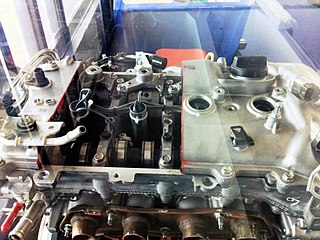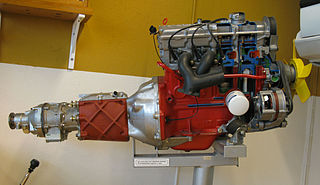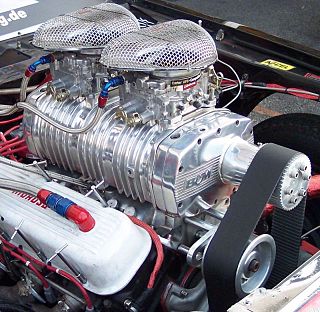
A camshaft is a shaft that contains a row of pointed cams in order to convert rotational motion to reciprocating motion. Camshafts are used in piston engines, mechanically controlled ignition systems and early electric motor speed controllers.

In a piston engine, either a timing belt or timing chain or set of timing gears is a perishable component used to synchronize the rotation of the crankshaft and the camshaft. This synchronisation ensures that the engine's valves open and close at the correct times in relation to the position of the pistons.

Variable valve timing (VVT) is the process of altering the timing of a valve lift event in an internal combustion engine, and is often used to improve performance, fuel economy or emissions. It is increasingly being used in combination with variable valve lift systems. There are many ways in which this can be achieved, ranging from mechanical devices to electro-hydraulic and camless systems. Increasingly strict emissions regulations are causing many automotive manufacturers to use VVT systems.

VVT-i, or Variable Valve Timing with intelligence, is an automobile variable valve timing petrol engine technology manufactured by Toyota Group and used by brands Groupe PSA, Toyota, Lexus, Scion, Daihatsu, Subaru, Aston Martin, Pontiac and Lotus Cars. It was introduced in 1995 with the 2JZ-GE engine found in the JZS155 Toyota Crown and Crown Majesta.

An overhead camshaft (OHC) engine is a piston engine in which the camshaft is located in the cylinder head above the combustion chamber. This contrasts with earlier overhead valve engines (OHV), where the camshaft is located below the combustion chamber in the engine block.

The BMW M43 is an SOHC four-cylinder petrol engine which was produced from 1991-2002. The M43 powered base-model cars, while higher performance models at the time were powered by the BMW M42 and BMW M44 DOHC engines. The M43 was produced at the Steyr engine plant.

An overhead valve (OHV) engine, sometimes called a pushrod engine, is a piston engine whose valves are located in the cylinder head above the combustion chamber. This contrasts with flathead engines, where the valves were located below the combustion chamber in the engine block.

A belt is a loop of flexible material used to link two or more rotating shafts mechanically, most often parallel. Belts may be used as a source of motion, to transmit power efficiently or to track relative movement. Belts are looped over pulleys and may have a twist between the pulleys, and the shafts need not be parallel.

The Valvetronic system is a BMW variable valve lift system which, in combination with VANOS, allows infinite adjustment of the intake valve timing and lift. The system claims to improve fuel economy and emissions, and negates the need for a throttle body in regular use.

The Volvo B21 is a slanted straight-four engine first used in the Volvo 200 series, meant to replace the B20. The B21 and all derived engines are often referred to as red block engines for the red paint applied to the block. The primary differences when compared to the B20 was the switch to a SOHC in place of the older pushrod configuration, and an aluminum crossflow cylinder head versus the iron head of the B20.

A toothed belt, timing belt, cogged belt, cog belt, or synchronous belt is a flexible belt with teeth moulded onto its inner surface. Toothed belts are usually designed to run over matching toothed pulleys or sprockets. Toothed belts are used in a wide array of mechanical devices where high power transmission is desired.

A valvetrain is a mechanical system that controls the operation of the intake and exhaust valves in an internal combustion engine. The intake valves control the flow of air/fuel mixture into the combustion chamber, while the exhaust valves control the flow of spent exhaust gases out of the combustion chamber once combustion is completed.

The Family II is a straight-4 piston engine that was originally developed by Opel in the 1970s, debuting in 1981. Available in a wide range of cubic capacities ranging from 1598 to 2405 cc, it simultaneously replaced the Opel CIH and Vauxhall Slant-4 engines, and was GM Europe's core mid-sized powerplant design for much of the 1980s, and provided the basis for the later Ecotec series of engines in the 1990s.

The Renault Energy engine also known as "E engine" or "E-Type" is an automotive gasoline four-stroke inline four cylinder internal combustion engine, with a sleeved water cooled cast iron block, equipped with 5 crankshaft bearings, an overhead camshaft driven by a toothed timing belt and an aluminum cylinder head with 8 overhead valves. Developed and produced by Renault in the late 1980s, the engine made its first appearance in the Renault 19.
An interference engine is a type of 4-stroke internal combustion piston engine in which one or more valves in the fully open position extends into any area through which the piston may travel. By contrast, in a non-interference engine, the piston does not travel into any area into which the valves open. Interference engines rely on timing gears, chains, or belts to prevent the piston from striking the valves by ensuring that the valves are closed when the piston is near top dead center. Interference engines are prevalent among modern production automobiles and many other four-stroke engine applications; the main advantage is that it allows engine designers to maximize the engine's compression ratio. However, such engines risk major internal damage if a piston strikes a valve due to failure of camshaft drive belts, drive chains, or drive gears.
Variable valve timing (VVT) is a system for varying the valve opening of an internal combustion engine. This allows the engine to deliver high power, but also to work tractably and efficiently at low power. There are many systems for VVT, which involve changing either the relative timing, duration or opening of the engine's inlet and exhaust valves.
The Subaru six-cylinder engines are a series of flat-6 engines manufactured by Subaru, made in three distinct generations. The ER27, derived from the Subaru EA first-generation flat-4, was used as the sole engine option in the premium model 1988–91 Subaru Alcyone VX. The EG33, derived from the Subaru EJ second-generation flat-4, was used exclusively in the successor Subaru Alcyone SVX, again as its sole engine option, sold from 1991–96. The EZ series, consisting of the EZ30 and EZ36 models, was designed to be almost as compact as the EJ25 flat-4. The EZ30/36 were the first Subaru six-cylinder engines available outside the sport coupes, used as the uplevel option for Subaru Legacy (2002–19) and Outback/Lancaster (2001–19) as well as the sole option in the Subaru Tribeca (2006–14).













